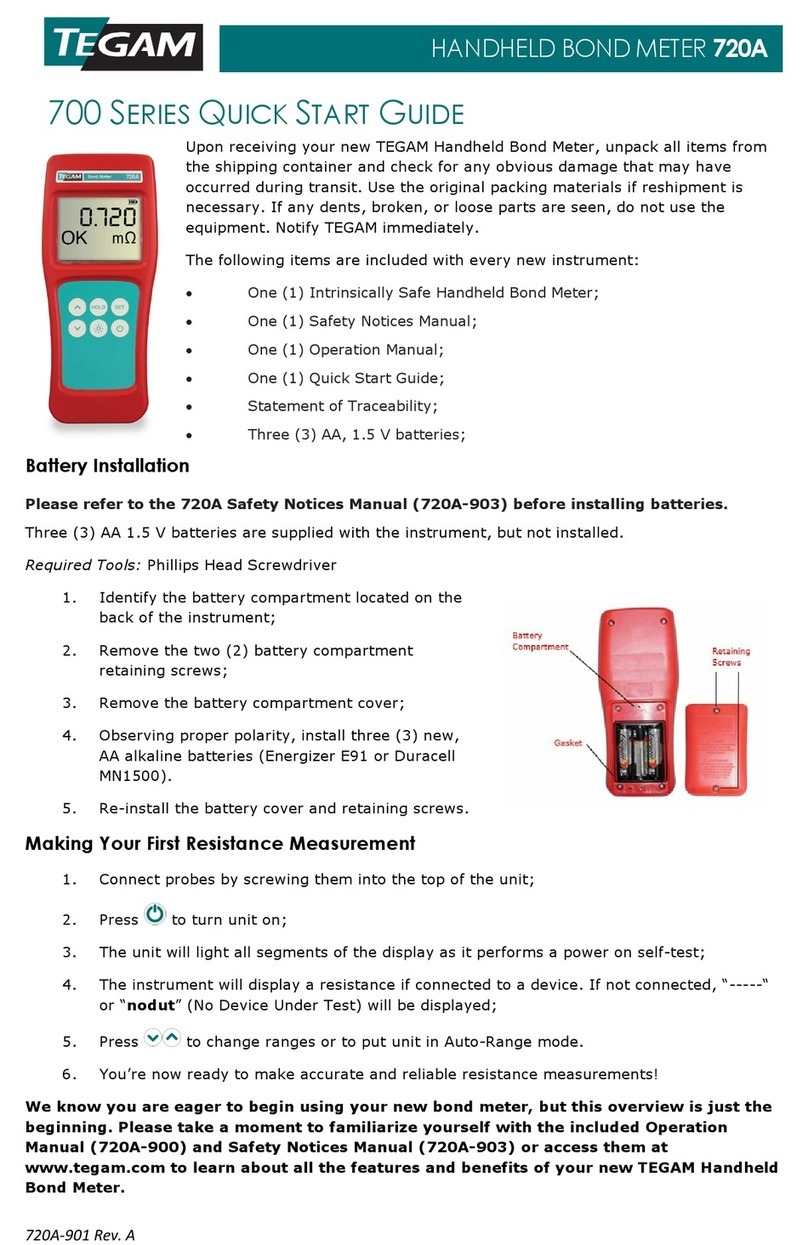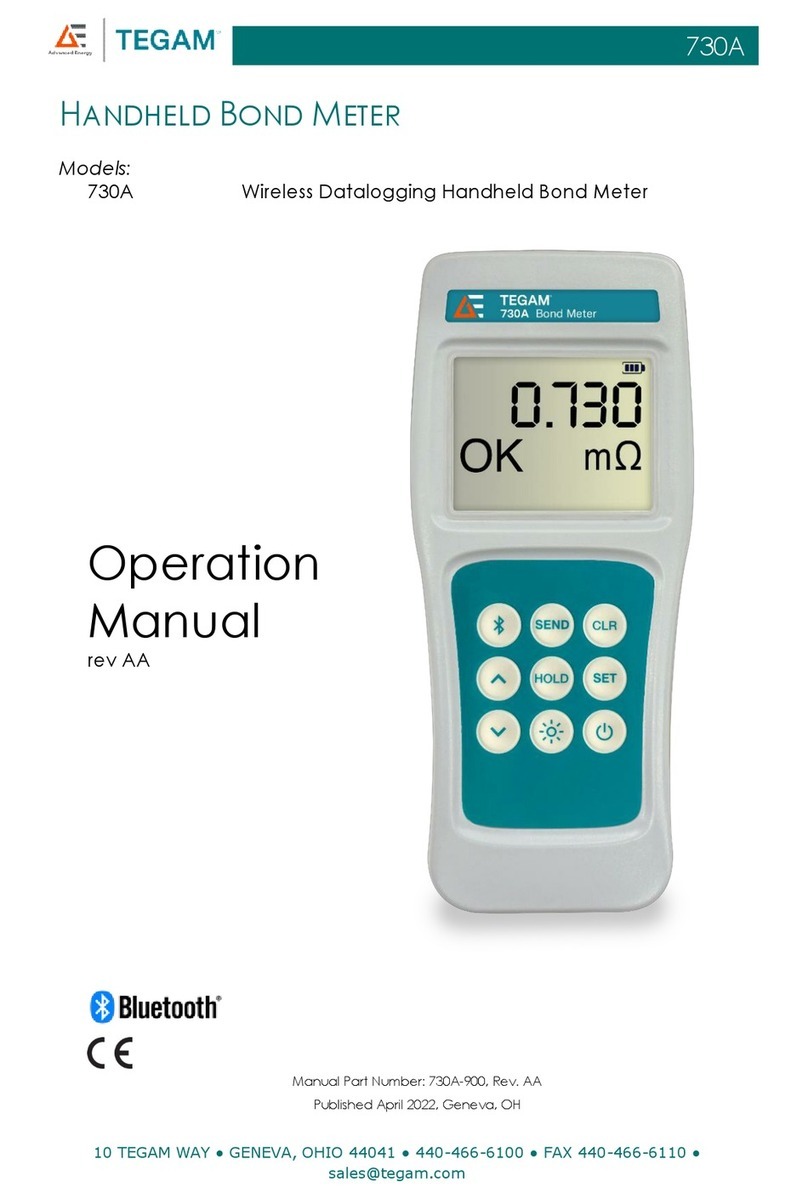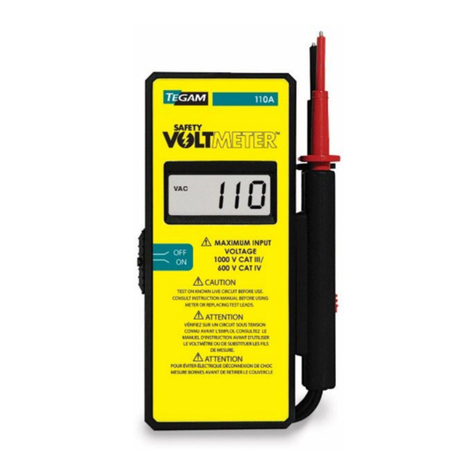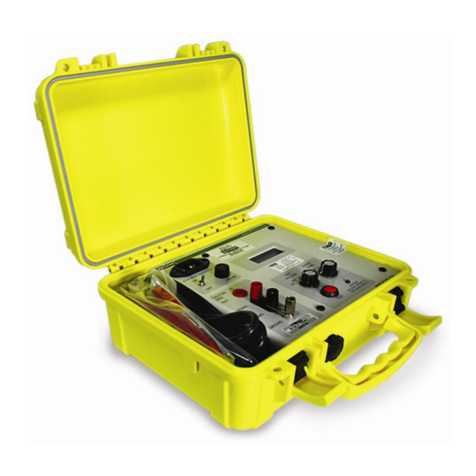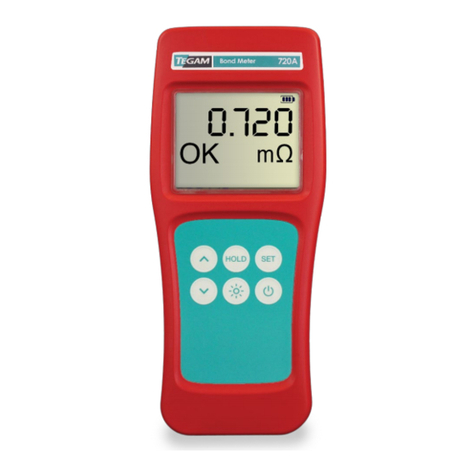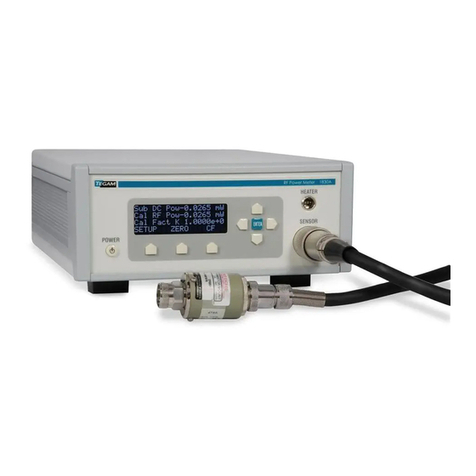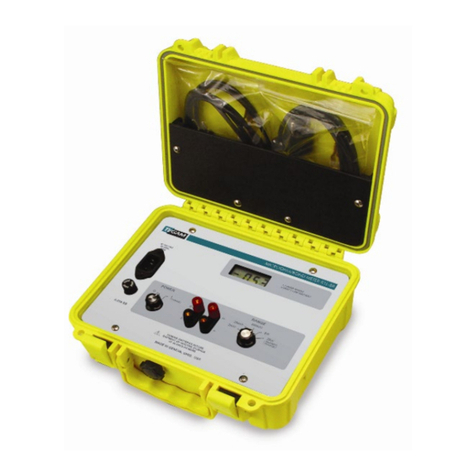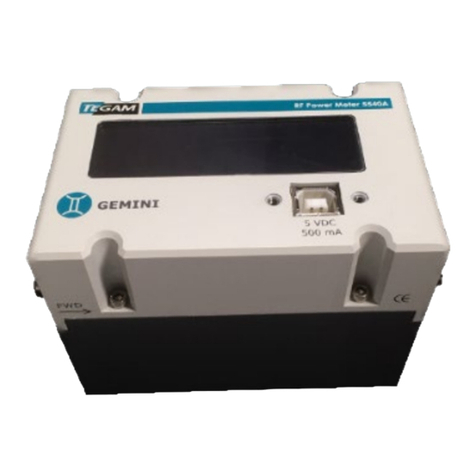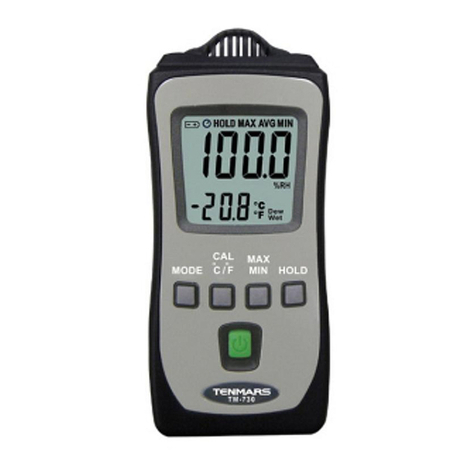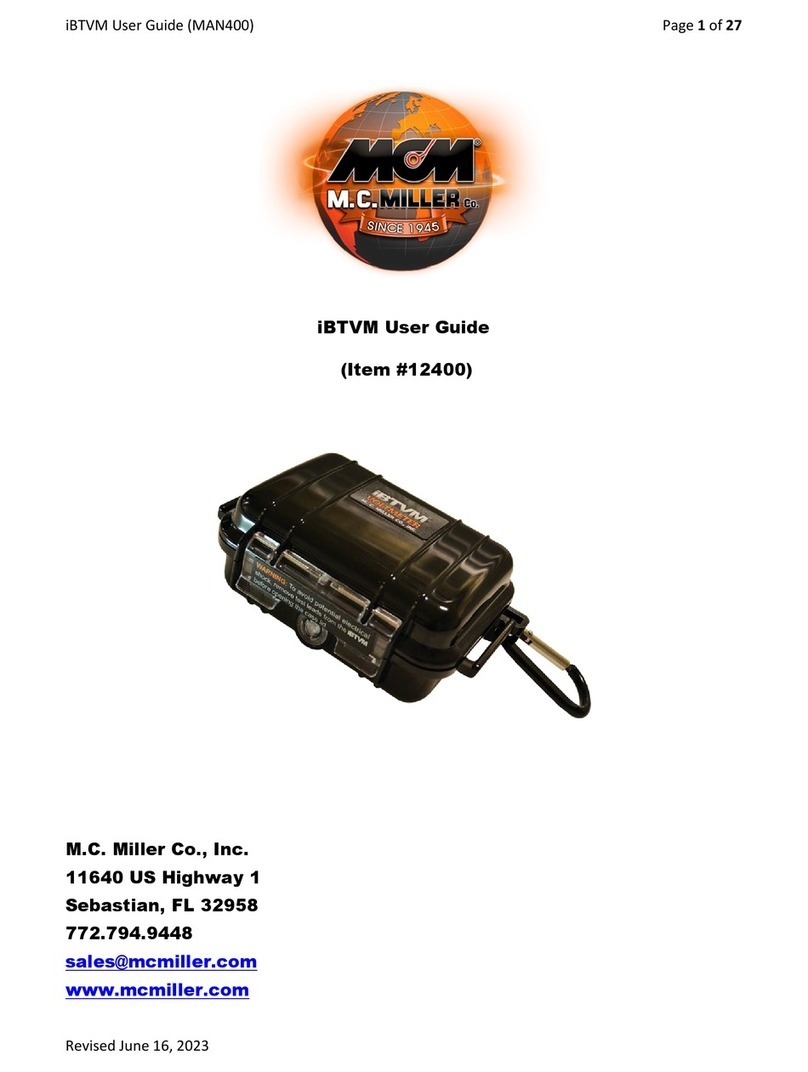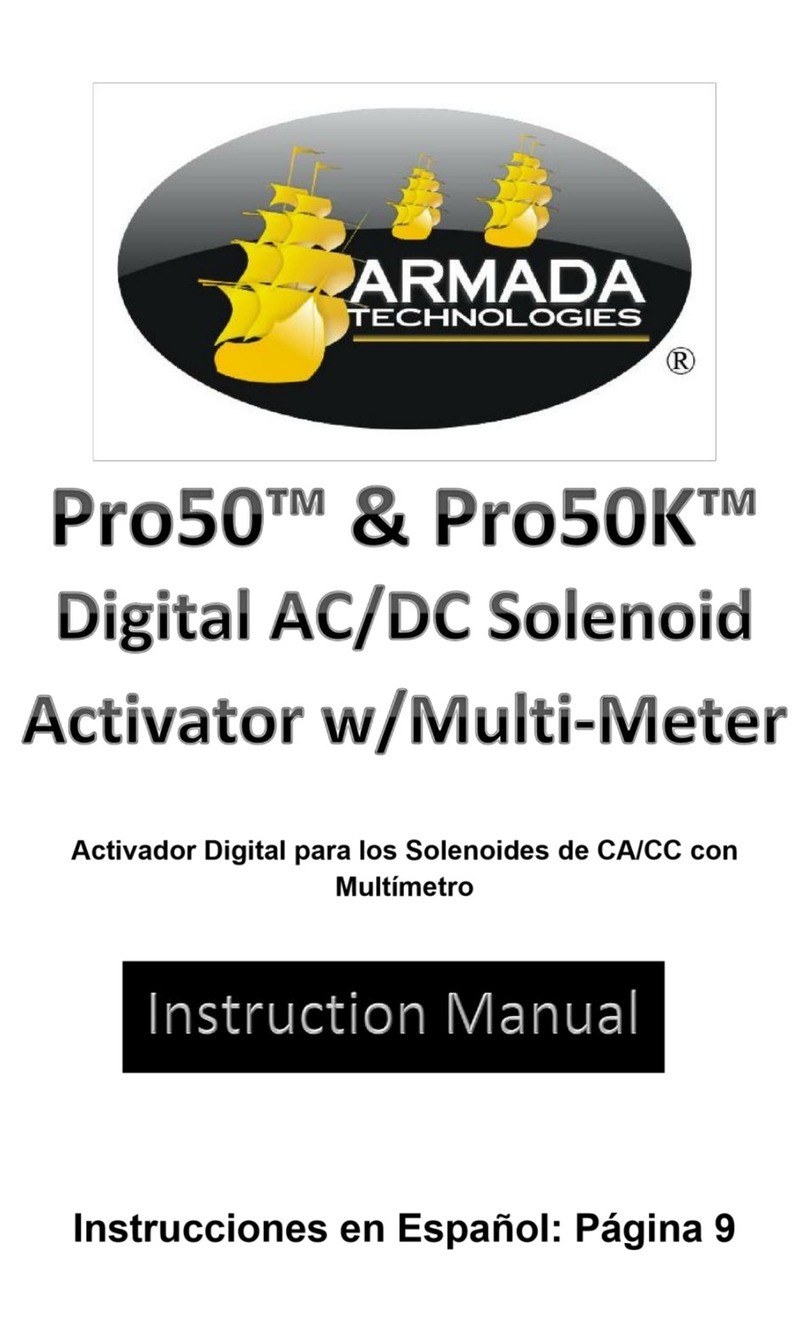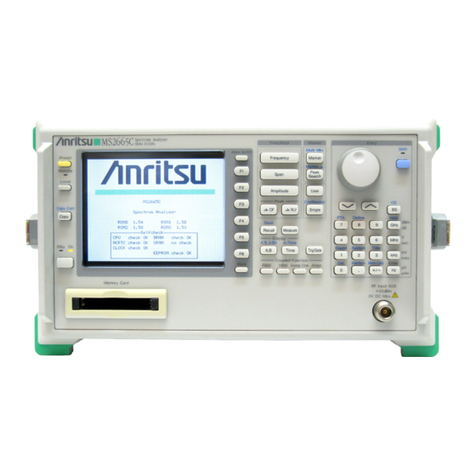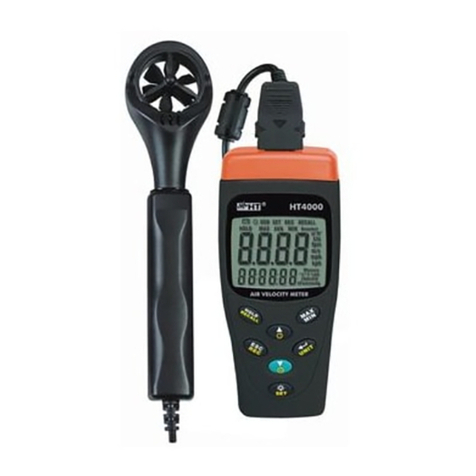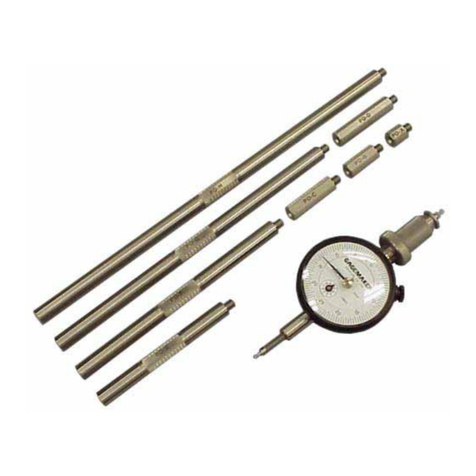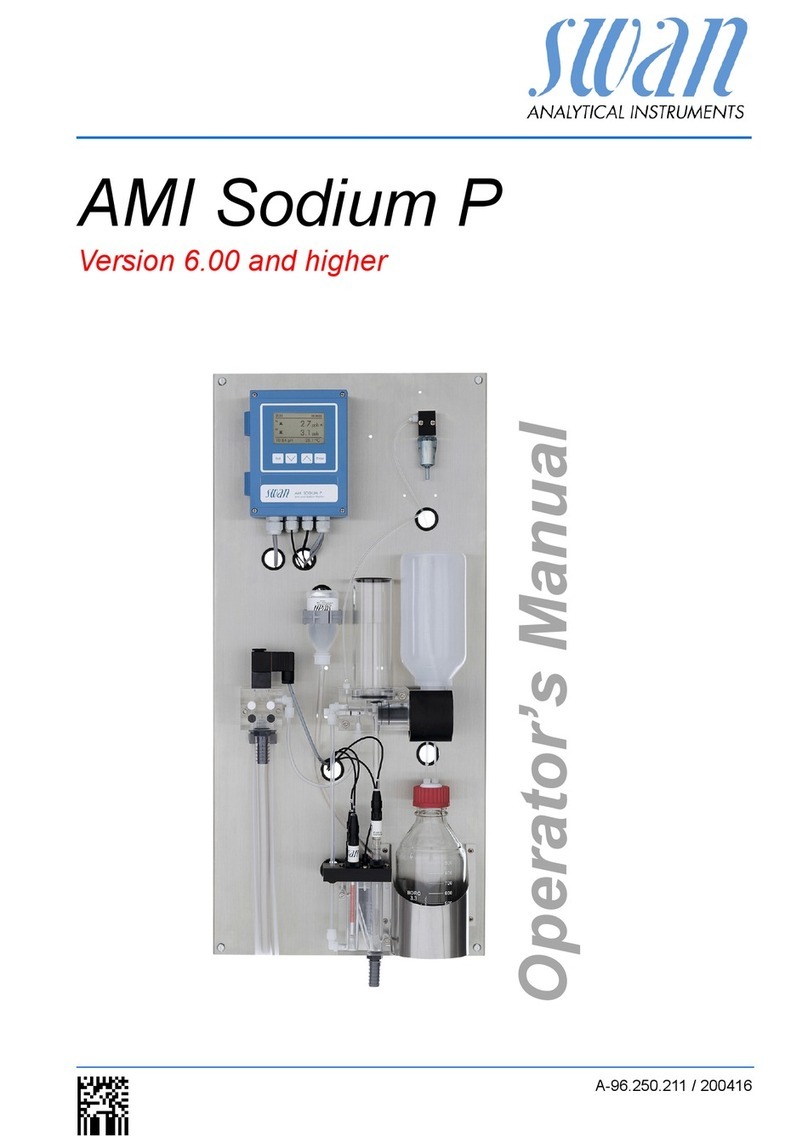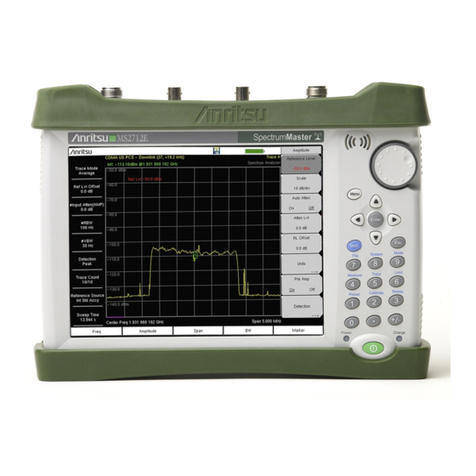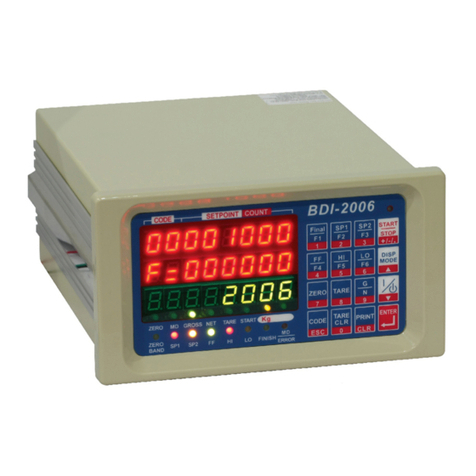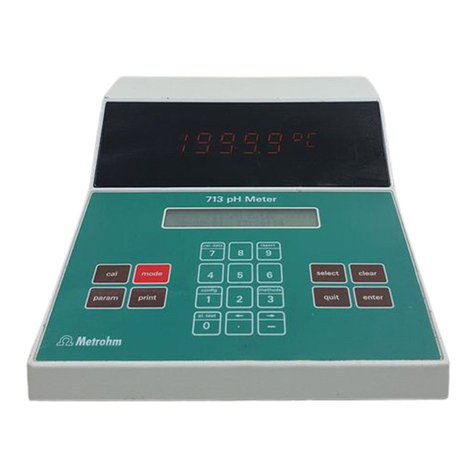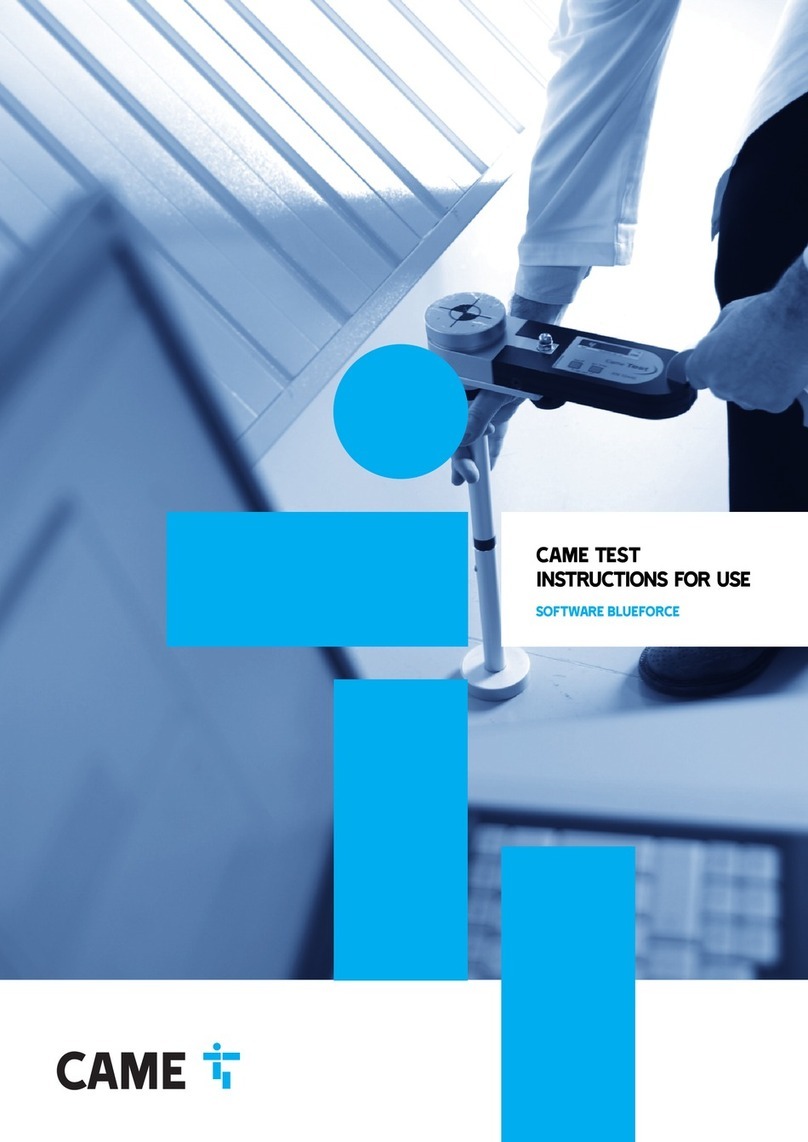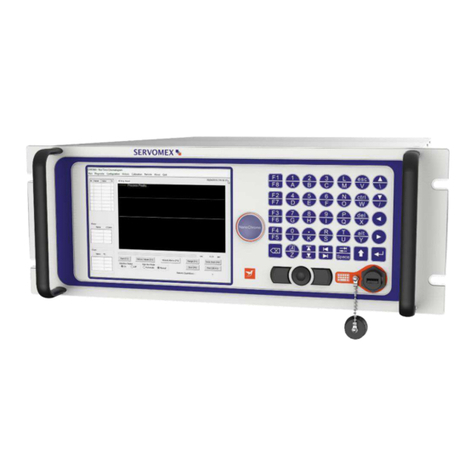Tegam 253 User manual

10 TEGAM WAY • GENEVA, OHIO 44041 • 440-466-6100 • FAX 440-466-6110 • sales@tegam.com
253
General Purpose, Portable
Impedance/LCR Meter
MODEL 253
Instruction Manual
PN# 253-840
Publication Date: February 2020
Rev. N
NOTE: This User’s Manual was as current as possible when this product was manufactured. However,
products are constantly being updated and improved. To ensure you have the latest documentation,
refer to www.tegam.com.

10 TEGAM WAY • GENEVA, OHIO 44041 • 440-466-6100 • FAX 440-466-6110 • sales@tegam.com
253

III
TABLE OF CONTENTS
TABLE OF CONTENTS
1
DESCRIPTION
1.
1
I
N
TR
OD
U
C
TI
ON
............................................................................................
1-
1
1
.
2
S
P
E
C
I
F
I
C
A
T
I
O
N
S
..........................................................................................
1
-
2
2
OP
ER
A
T
I
O
N
2
.
1
CO
NT
R
O
LS
AND
CO
NNE
C
T
O
R
S
........................................................................
2
-
1
2
.
1
.
1
F
r
on
t
P
a
n
e
l
....................................................................................
2
-
1
2
.
1
.
2
R
ea
r
P
a
n
e
l
......................................................................................
2
-
3
2
.
2
O
P
E
R
A
T
I
N
G
P
R
OC
E
DU
R
E
.................................................................................
2
-
4
2
.
2
.
1
P
o
we
r
R
e
qu
ir
e
m
e
n
ts
.......................................................................
2
-
4
2
.
2
.
2
A
pp
l
y
i
ng
P
o
w
e
r
..............................................................................
2
-
5
2
.
2
.
3
C
onn
ect
io
n
t
o
U
n
kn
ow
ns ................................................................
2-
5
2
.
2
.3.1
Te
st
Fi
xtur
e
C
o
mpe
n
sa
ti
on
...................................
2
-
7
2
.
2
.
4
Fu
nc
ti
on
S
e
le
c
t
io
n
..........................................................................
2
-
8
2
.
2
.
5
R
a
ng
e
S
e
l
e
c
t
i
on
.............................................................................
2
-
11
2
.
2
.
6
S
u
mm
a
r
y
o
f
O
p
e
r
a
t
i
on
...................................................................
2
-
12
2
.
3
ME
A
S
U
R
E
M
E
N
T
TECH
N
I
QU
E
S
..........................................................................
2-
13
2
.
3
.
1
R
e
si
sta
n
c
e
Me
a
s
ur
e
m
e
n
ts
a
t
1 k
H
z
...................................................
2
-
13
2
.
3
.
2
C
a
pa
c
ita
nc
e
Me
a
s
ur
e
m
e
n
ts
..............................................................
2
-
16
2
.
3
.
3
I
ndu
ctan
ce Meas
u
r
eme
n
ts
...............................................................
2
-
16
2
.
3
.
4
D
e
te
r
m
i
n
i
ng
Q
u
a
li
t
y
Fa
c
t
or
(Q)
of
I
ndu
c
t
o
r
s
.....................................
2
-
16
2
.
3
.
5
D
e
te
r
m
i
n
in
g
D
i
ssi
pa
tio
n
Fa
c
t
or
(D
)
o
f
Cap
aci
t
o
rs
us
i
ng
Nom
og
r
aph ............................................................
2-
17
2
.
3
.
6
Us
in
g
the
Bia
s
Fe
a
t
ur
e
.....................................................................
2
-
19
2
.
3
.
7
S
i
gna
l
Out
pu
t
Te
r
m
ina
l
s
..................................................................
2
-
20
2
.
3
.
8
M
ea
s
ur
i
ng
Gr
ound
e
d
U
n
k
n
ow
ns........................................................
2
-
20
2
.
3
.
9
Me
a
s
ur
i
ng
Ba
tte
r
y
I
m
peda
nc
e
..........................................................
2
-
22
3
CIRCUIT DESCRIPTION
3
.
1
G
E
N
E
R
A
L
D
E
SC
R
I
P
T
I
O
N
...............................................................................
3
-
1
4 MAINTENANCE
4.1 CALIBRATION PROCEDURE........................................................................... 4-
1
4.1.1 Power Supply Check .......................................................................... 4-
2
4.1.2 Oscillator Adjust................................................................................ 4-
2
4.1.3 L, C, R, G Alignment .......................................................................... 4-
2
4.1.4 Dissipation Factor (D) Alignment ......................................................... 4-
3

IV
TABLE OF CONTENTS
TABLE OF CONTENTS (continued)
4.2 MAINTENANCE ........................................................................................... 4-5
4.2.1 Preventive Maintenance...................................................................... 4-
5
4.2.1.1 Cleaning........................................................................................ 4-
5
4.2.1.2 Visual Inspection ............................................................................ 4-
5
4.3 PREPARATION FOR CALIBRATION OR REPAIR SERVICE .................................... 4-
6
4.4 WARRANTY ................................................................................................ 4-
8
Appendix A (for 253/SP2598)
Instrument Description ........................................................................... A-1
Performance Specifications ...................................................................... A-2
Battery Removal/Replacement ................................................................. A-3
DANGE
R
O
U
S
V
O
L
T
AG
E
P
O
T
E
NTI
A
LS
EXIST
I
N
SIDE
T
H
IS
INST
RU
MENT
.
MAINT
E
N
A
NCE
INST
RUCT
IONS
W
I
T
H
I
N
T
H
IS
M
A
NUA
L
A
R
E
F
O
R
US
E
B
Y
QUA
L
I
F
IED
SE
RVICE
P
E
RSO
NN
EL
O
N
L
Y
.
TO
AV
OI
D
ELEC
TR
I
C
AL
S
H
OC
K
,
D
O
NO
T
AT
T
E
MPT AN
Y
S
E
R
V
I
C
I
N
G
OTH
E
R
THAN TH
AT
CO
NTAIN
E
D
IN
T
H
E
O
P
E
R
AT
I
O
N
INST
RUC
T
IONS
UNLE
SS
Y
O
U
ARE
QUALIFIE
D
T
O
D
O
SO
.

1-1
DESCRIPTION
SECTION 1
DESCRIPTION
1.1 INTRODUCTION
Model 253 Digital Impedance/LCR Meter is a semi-automatic instrument which permits rapid
measurement of inductance (L), capacitance (C), resistance (R), conductance (G) and dissipation
factor (D) at a test frequency of 1 kHz. Measurement accuracy and versatility satisfies most
demanding engineering or scientific applications.
To operate, merely push the button for the desired function, manually turn the knob to the
desired range, and connect the unknown. KELVIN KLIPS® test leads are included, thus ensuring
true four-terminal connections. The position of the range switch, used in conjunction with the
desired function button and front panel range scale, indicate the unit of measurement being
displayed by the 3½ digit LED readout.
Excellent reliability of the Model 253 Impedance/LCR Meter is assured through use of solid-state
devices and etched circuit board construction. Its small size is ideal for use on bench tops
where work space may be at a premium. The carrying handle tilts the unit to a convenient
viewing angle. Rear panel brackets provide line cord storage and enable it to be operated in a
vertical position.

1-2
DESCRIPTION
1.2 SPECIFICATIONS
Ranges
0
1
2
3
4
5
6
7
Full Scale
Values
L
s
200 µH
2 mH
20 mH
200 mH
2 H
20 H
200 H
200 H
C
p
200 pF
2 nF
20 nF
200 nF
2 µF
20 µF
200 µF
2000 µF
R
s
2 Ω
20 Ω
200 Ω
2000 Ω
20 kΩ
200 kΩ
2000 kΩ
2000 kΩ
G
p
2 µS
20 µS
200 µS
2000 µS
20 mS
200 mS
2000 mS
20 S
D
1.999
Accuracy
(15°C to 35°C)
L
s
±(0.25% +
(1+0.002Rs*)
digits)**
±(0.25% + (1+0.001R
s
*) digits)
±(0.25% +
(1+0.010Rs*)
digits)
±(0.25% +
(1+0.010Rs*)
digits)
C
p
±(0.25% +
(1+0.002Gp*)
digits)**
±(0.25% + (1+0.001G
p
*) digits)
±(0.25% +
(1+0.010Gp*)
digits)
±(0.5% +
(1+0.004Gp*)
digits)
R
s
±(0.25% +
(1+0.002Ls*)
digits)
±(0.25% + (1+0.001L
s
*) digits)
±(0.25% +
(1+0.010Ls*)
digits)
±(0.25% +
(1+0.010Ls*)
digits)
G
p
±(0.25% +
(1+0.002Cp*)
digits)
±(0.25% + (1+0.001C
p
*) digits)
±(0.25% +
(1+0.010Cp*)
digits)
±(0.5% +
(1+0.004Cp*)
digits)
D
±(1%+0.002) for L or C ≥ 200 counts
±(2%+0.010) for L or C 50 to 199 counts
±(2%+0.10)
Test
Signal
Voltage
Cp, Gp
1.0 V
RMS
0.1 V
RMS
0.01 V
RMS
Current
Ls, Rs
100 mA
10 mA
1 mA
100 µA
10 µA
1 µA
*Digit Count, same range.
** After correction for test lead zero reading.
0 °C to 15 °C and 35 °C to 50 °C : add 0.1(rated accuracy)/°C
Table 1-1. Model 253 Specifications
Sample calculation:
Lets find the accuracy for 100 µF capacitor.
From the above table, the accuracy formula is ±[0.25% + (1 + 0.010Gp)digits]
=±[(.
x 100 x 10) + (1 + 0.010(1 x 10))digits]
( = 1 µ)
=±[0.25 µF + 1 digit]
(1 0.1 µ 3
& 200.0 µ)
=±0.35 µF
So the limits are,100 µF ± 0.35 =(100.35 99.65)µF

1-3
DESCRIPTION
Test Frequency: 1 kHz ± 1%.
Unknown Excitation: The 1 kHz voltage (Vx) and current (Ix) levels listed in Table 1-1 are held
constant by an internal amplitude control circuit.
Measurement Rate: Four per second; one second is required for first reading after connecting
unknown to terminals.
Measurement Display: 3½ digit LED with decimal point. Blanked for overload conditions.
Unit Display: Unit of mesurement being displayed by the LED readout is indicated by
position of the range switch, used in conjunction with the desired function
button and the front panel range scale.
External Bias: Rear panel terminals are provided for connection of external supply. 0 V to
50 VDC, 0.1 A maximum. (Read Section 2.3.6 before using external bias.)
Static Charge Protection: Diode and resistor discharge network.
Connection to Unknown: Four-terminal, shielded, connections are provided by the KELVIN KLIPS®
cable assembly (TEGAM Part No. #CA-162-36) supplied with the Model 253.
Outputs: Analog signals of 1 V per 1,000 counts, 1 kΩ source resistance is available
at rear panel.
L, C, R, or G, with simultaneous output of D for L or C.
Power Consumption: 4 W typical.
Power Requirements: 100 to 125 VAC or 200 to 250 VAC, 50/60 Hz.
Fuse: 110 V: 1/16 A 250 VAC 3AG Slow-Blow TEGAM Part No. # 8952
220 V: 1/20 A 250 VAC 5x20 mm Slow-Blow TEGAM Part no. # 53327
* denotes that carrier adapter (TEGAM Part No. # 45965) is needed to use a 5x20 mm fuse
For model 253/SP2598,
110 V: 1/8 A 250 VAC Slow-Blow TEGAM Part No. # 50028
220 V: 1/16 A 250 VAC 3AG Slow-Blow TEGAM Part No. # 8952
Size: Height (with feet) – 100 mm (4 in.)
Width – 260 mm (10 in.)
Depth (overall) – 370 mm (14.6 in.)
Weight: 3.2 kg (7 lb.)
Accessories supplied with Model 253: TEGAM Part No.
KELVIN KLIPS® Four-Terminal Clips CA-162-36
Instruction Manual 253-840
Socket, 0.062” Crimp, Molex 02-06-5106 062-261
Pin, 0.062” Crimp, Molex 02-06-6103 062-263
Options Available: TEGAM Part No.
4-Terminal Kelvin Chip Tweezers 2005B/SP5132
Kelvin Klip replacement kit KK100
Front Panel Dust Cover 43374
Chip Tweezer Rebuild Kit 47422

2-1
OPERATION
SECTION 2
OPERATION
2.1 CONTROLS AND CONNECTORS
2.1.1 Front Panel
Figure 2-1. Model 253 Front Panel
1. ON/OFF Switch A push-on, push-off switch for applying and removing power from the
instrument.
2. UNKNOWN Connector Terminals designed to be used with KELVIN KLIPS® test leads
(TEGAM Part No. # CA-162-36), provided with Model 253, to provide
a true four-terminal connection to the unknown or test fixture.
3. L, R, C, and G Pushbuttons Function pushbuttons select the type of meter circuit that will
measure series inductance (L) and resistance (R) or parallel
capacitance (C) and conductance (G).
4. D Pushbutton The push-to-read D (dissipation factor) pushbutton displays the D of a
capacitor or inductor when the C or L function is selected.
5. Range Switch Selects the decimal multiplier and units of measurement for the meter
circuit being used. Each range, 0 – 7, can be individually selected or
the AUTO position puts the instrument in auto ranging mode.
6. Display A 3½ digit readout for all functions.

2-2
OPERATION
7. Units Indicators Front panel LED lamps indicate the units of measurement. The basic
multipliers and units are: H (henrys), mH (millihenrys), µH
(microhenrys), nF (nanofarads), kΩ (kilohms), Ω (ohms), S
(siemens), mS (millisiemens), µS(microsiemens) and D (dissipation
factor).
8. Tilt-stand Handle Aids portability; tilts instrument for easier viewing of the LED display.

2-3
OPERATION
2.1.2 Rear Panel
Figure 2-2. Model 253 Rear Panel
1. Bias Terminals Allows application of a 2 V to 50 VDC, 0.1 A maximum bias to the capacitor
being measured. (The shorting bar must be in place when not using bias
feature.) See Section 2.3.6 before using external bias.
2. Output Terminals Provides two analog signals proporational to the function selected (L, R, C, or
G) and D (for L and C). These terminals can be used with external DVM’s (for
increased full scale readings or resolution capability), with chart recorders, or
with limits comparators.
3. Fuse 110 V: 1/16 A 250 VAC 3AG Slow-Blow TEGAM Part No. # 8952
220 V: 1/20 A 250 VAC 5x20 mm Slow-Blow TEGAM Part No. # 53327
For model 253/SP2598,
110 V: 1/8 A 250 VAC Slow-Blow TEGAM Part No. # 50028
220 V: 1/16 A 250 VAC 3AG Slow-Blow TEGAM Part No. # 8952

2-4
OPERATION
2.2 OPERATING PROCEDURE
2.2.1 Power Requirements
Before turning the power ON, make sure the instrument is set to the proper line voltage.
The Model 253 Impedance/LCR Meter contains an internal slide switch to select the nominal line
voltage (see Figure 2-3). In its up position, the switch selects 100 to 125 VAC, 50/60 Hz operation.
In the down position it selects 200 to 250 VAC, 50/60 Hz operation.
WHEN CHANGING FROM 110 VAC OPERATION TO 220 VAC OPERATION (OR IN
OPPOSITE ORDER), BE SURE TO REPLACE THE REAR PANEL AC FUSE WITH THE
PROPER VALUE FOR THE LINE VOLTAGE SELECTED.
Figure 2-3. Line Voltage Switch

2-5
OPERATION
2.2.2 Applying Power
The push-on, push-off, ON/OFF button in its depressed position applies power to the measurement
circuitry. When power is applied, the LED display lights and reads zero when in C and G modes or the
display is blank with the decimal point lit in the L and R modes.
2.2.3 Connection to Unknowns
The KELVIN KLIP® test lead set (TEGAM Part No. # CA-162-36) is plugged into the 253’s front panel
UNKNOWN connector. The test leads connector cover is spring-locking and should be squeezed
together before inserting or removing.
The test leads provide a shielded, four-terminal connection to the unknown (see Figure 2-4). The clip
with the red hinge-spool provides the HI DRIVE and HI SENSE connections to the unknown and the
clip with the black hinge-spool make the LO DRIVE and LO SENSE connections.
Figure 2-5a.

2-6
OPERATION
Figure 2-4.
For connection to three terminal unknowns (the third connection is to ground), a ground wire must
be added to the test lead set. This wire is connected as in Figure 2-5.
Figure 2-5

2-7
OPERATION
2.2.3.1 Test Fixture Compensation
The Model 253 uses a 3.3 pF capacitor (C6 in Figure 2-6) to compensate for the capacitance of the
test leads. If the 253 is used with a test fixture, the larger capacitance of the fixture must also be
compensated for. There are two methods for compensating this larger capacitance. The first method
is to make a zero capacitance measurement with the test fixture connected. This reading is mentally
subtracted from all other measurements.
The second method for compensating the larger capacitance is to change the value of C6 from 3.3
pF to 10 pF and to add an external trim capacitor. The external trim capacitor is connected in
parallel with the unknown and should be of such a value that the test fixture capacitance can be
trimmed to zero. Typically, the maximum value of this trim capacitor is 15 pF. The trim capacitor
can either be added to the test cable, between Terminals 1 and 3 of the connector as shown in
Figure 2-6, or it can be added to the test fixture.
Figure 2-6. Test Fixture Compensation

2-8
OPERATION
2.2.4 Function Selection
Model 253 Impedance/LCR Meter is designed to measure series inductance (L), parallel capacitance
(C), series resistance (R), parallel conductance (G), and dissipation factor (D) of inductance and
capacitance. One of these measurement modes is selected by depressing the proper front panel
button. (If all buttons are in their out position, the instrument reverts to the inductance
measurement mode.)
Example: Select the capacitance measurement function. (Depress the C pushbutton.)

2-9
OPERATION
Example: Select the conductance measurement function. (Depress the G Pushbutton.)
If a negative sign appears on the display when measuring an unknown, possible causes are:
• “C” button has been pushed when measuring an inductor.
• “L” button has been pushed when measuring a capacitor.
• The unknown is more capacitive (or inductive) than suspected. For example, an
Inductor that resonates below 1 kHz will measure as though it were a capacitor.
• A diode requires bias voltage (a negative reading may appear if bias voltage is not applied).

2-10
OPERATION
To measure the dissipation factor (D) of a capacitor or inductor, push and hold the D button while
the C or L function is selected. (The display will blank if D is pushed, while the unit is in R or G mode
and the unknown is resistive).
When measuring the conductance (G) of a capacitor or the resistance (R) of an inductor, the R or G
reading may be quite small. In trying to acquire more resolution by moving the range switch to the
next lower range, the display will usually blank, indicating overload. Blanking occurs because the
instrument is still monitoring the reactive component (L or C) in addition to measuring and
displaying the loss component (R or G). In moving to the next lower range, the reactive component
becomes too large for the lower range causing overload and a blanked display.
Example: while measuring a 0.82 µF capacitor using the 2 µF range, the 253 display reads:
Switching to the conductance (G) mode, the display may read:

2-11
OPERATION
Trying to investigate this reading, you down range from the 20 mS range to the 2000 µS range.
The display blanks:
The display blanks because while ranging from 20 mS to 2000 µS, the capacitance range changed
from 2 µF to 200 nF. Since 0.82 µF is too large to measure on the 200 nF range, an overload occurs
and the display blanks.
2.2.5 Range Selection
Measurement ranges are selected either manually or automatically via a nine position rotary switch.
Switch positions 0 – 7 manually select the corresponding range (See Figure 2 – 7). For maximum
accuracy, select the range that gives the largest on-scale reading. The AUTO position automatically
selects the lowest corresponding range to give the highest resolution display.
Figure 2–7. Range Chart

2-12
OPERATION
Auto ranging operates for the major component of the unknown i.e., C for capacitors, L for
inductors, R for resistors. When measuring the minor component of the unknown, i.e. R of
inductors, G of capacitors, use manual ranging.
The units of the displayed reading, i.e. µH, mH, etc., are indicated by front panel LED lamps. If
either the reactive or resistive value of the unknown exceeds the range selected, the display will
blank.
Example: Set the instrument to measure 100 pF capacitors.
Example: Set the instrument to measure 100 kΩresistors.
If the value of a component is not known, set the instrument to its highest range before connecting
the test leads. Step the instrument down one range at a time until the range with the highest
resolution is reached. If the display is blank after the component is connected, the value of the
component is too large to measure directly, see Section 2.3 for alternate measurement techniques.
2.2.6 Summary of Operation
Press the appropriate function button (L, C, or G) and connect the KELVIN KLIPS® to the unknown.
For maximum accuracy, select the range that gives the largest on-scale reading. When the RANGE
switch is in AUTO position, the instrument automatically selects the lowest corresponding range to
give the highest resolution display. The measurement is displayed after one second or less.
Repetitive measurements are made at the rate of four per second. The range LED lamps indicate the
readout units (i.e. µH, mH, H, etc.). If the value of the unknown exceeds the range selected, the
display will remain blanked. To measure the dissipation factor of a capacitor or inductor, push and
hold the D button while the C or L function is selected.

2-13
OPERATION
2.3 MEASUREMENT TECHNIQUES
2.3.1 Resistance Measurements at 1 kHz
When using the resistance function, the maximum measurement is 1999 kΩ. For measurements from
1999 kΩ to 1000 MΩ, use the G (conductance) function where G=1/R or R=1/G. Measurement
accuracy is determined by ± (0.25% + 1 digit) where 1 digit will be ±100% at 1000 MΩ, ±10% at
100 MΩ and ±1% at 10 MΩ.
High-value, bobbin-type, wire-wound resistors have shunt capacitance which may affect
measurements by appearing as “-Ls”. This causes some difference between AC and DC resistance
measurement values.
The resistive component (Rs) of inductors and transformers, when measured at 1 kHz, will differ from
the DC winding resistance. If the core material is air or low loss (e.g. powdered permalloy), the AC
and DC values will be nearly equal. For laminated magnetic cores, the AC resistance will be greater
than the winding resistance (sometimes much greater). This is caused by the core losses which
change both with frequency and test current level.
2.3.2 Capacitance Measurements
Shielded devices. For shielded devices, the shield should be connected to the rear panel –Bias
terminal to provide proper guarding.
Most two- and four-terminal cables or sorting fixtures are not guarded immediately adjacent to
where the unknown capacitor is connected, and a zero capacitance reading can change by a few
picofarads whenever the ends of the cable or fixture terminals are physically moved. Always maintain
the physical orientation of the leads or terminals after checking for zero capacitance. Subtract zero-
capacitance reading from the capacitance reading for the unknown.
Table of contents
Other Tegam Measuring Instrument manuals
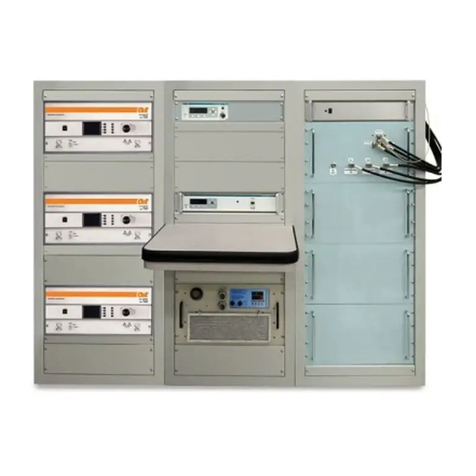
Tegam
Tegam 1316A User manual
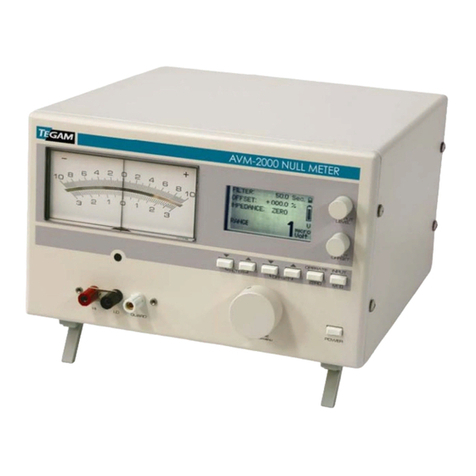
Tegam
Tegam AVM-2000 Troubleshooting guide
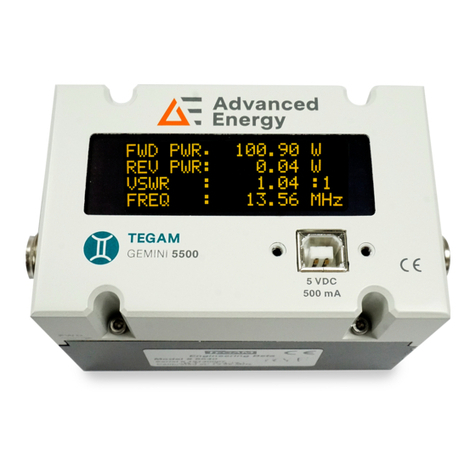
Tegam
Tegam Advanced Energy GEMINI 5540A User manual

Tegam
Tegam R1L-D1 User manual
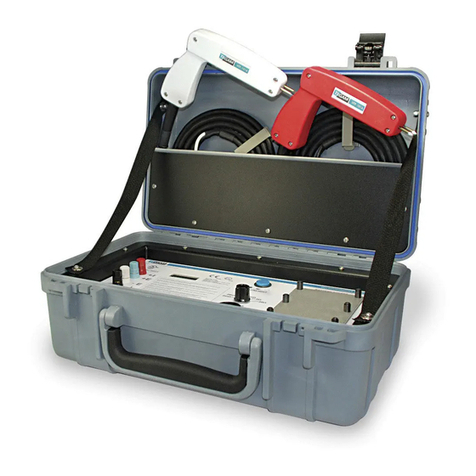
Tegam
Tegam R1L-E2A User manual
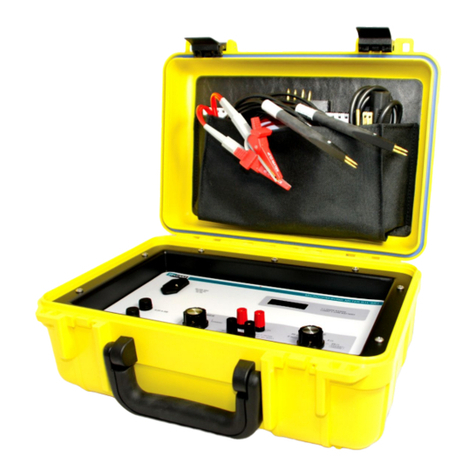
Tegam
Tegam R1L-BIR1 User manual
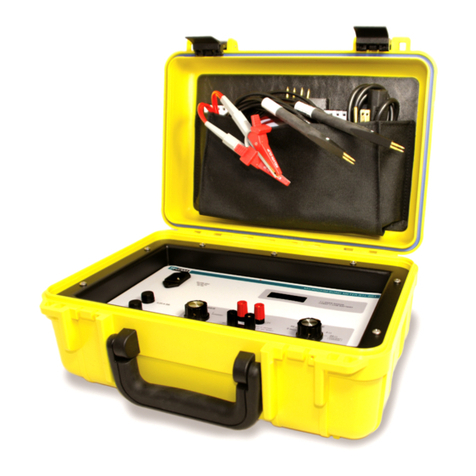
Tegam
Tegam R1L-BR1 User manual
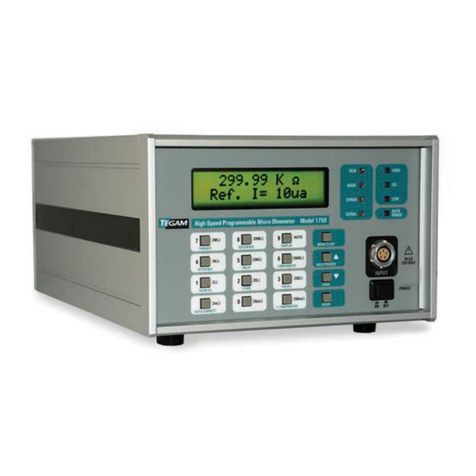
Tegam
Tegam 1750 User manual
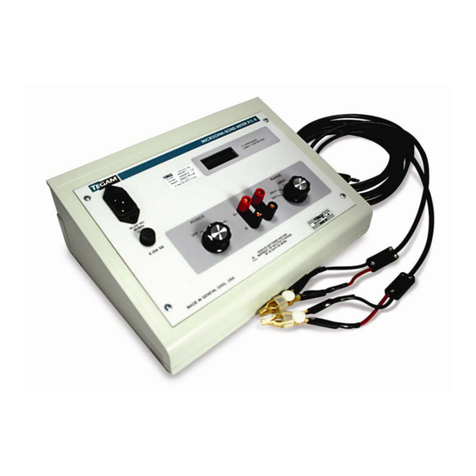
Tegam
Tegam R1L-B User manual
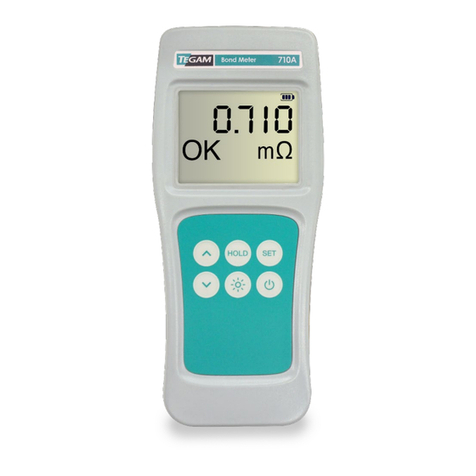
Tegam
Tegam 710A User manual
